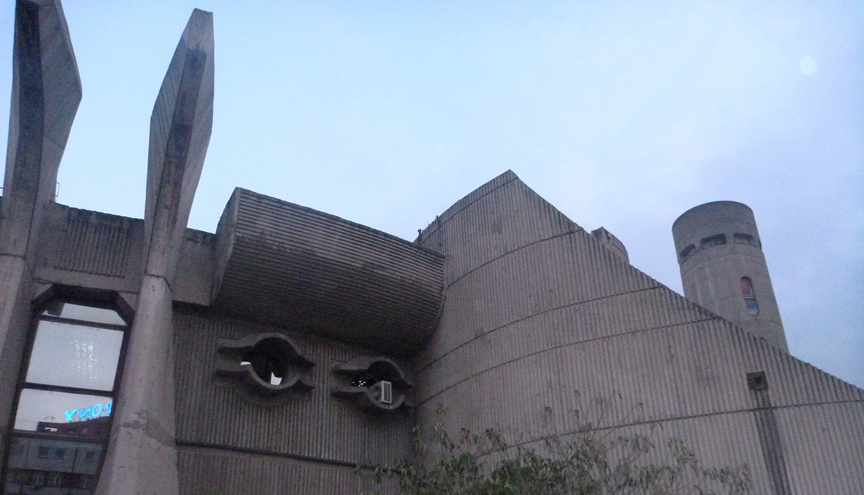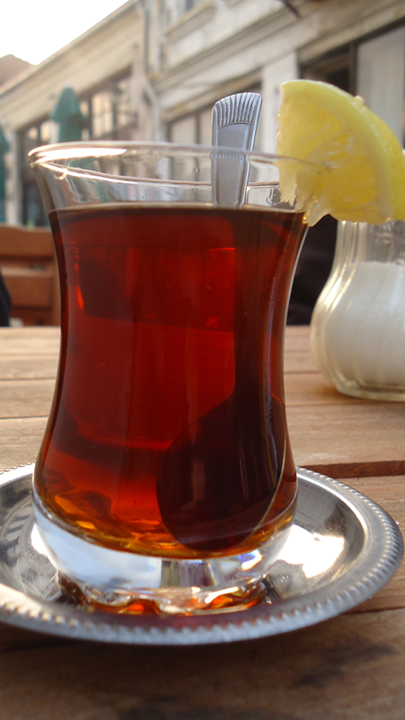You have /5 articles left.
Sign up for a free account or log in.
November 9, 2011: Macedonia Square, Skopje
By Charlie Hailey
The motorcade of Albanian Prime Minister Sali Berisha delays our visit to Skopje’s Main Post Office. Just like presidential parades in Washington, my colleague says. Berisha is in the country for conferences with Macedonia’s Foreign Minister and, later, with faculty at SUT, back in Tetova, my home base. He inspects Macedonia’s Honor Guard, some in old-style regimental dress, others in newly-designed uniforms. Leaders shake hands, the crowds finally disperse, and we cross over to the post office.
 Billboards for Lisca lingerie and T-Mobile obscure views of Janko Konstantinov’s late modernist masterpiece, but I am immediately struck by the building’s human scale—not because it’s dwarfed by newly-minted lions flanking the Vardar River bridge, but because its plastic form effortlessly extends and contracts to embrace both landscape and inhabitant. Arcing buttresses proffer gifts of dirt and grass, half-cylinder walls press in as ocular follies press out, and curved roofs mingle with clouds. Concrete that breathes earth and air.
Billboards for Lisca lingerie and T-Mobile obscure views of Janko Konstantinov’s late modernist masterpiece, but I am immediately struck by the building’s human scale—not because it’s dwarfed by newly-minted lions flanking the Vardar River bridge, but because its plastic form effortlessly extends and contracts to embrace both landscape and inhabitant. Arcing buttresses proffer gifts of dirt and grass, half-cylinder walls press in as ocular follies press out, and curved roofs mingle with clouds. Concrete that breathes earth and air.
Macedonian architecture students have been taught that famed architect Le Corbusier visited their country. Although one center of Corb’s universe resides at Mt. Athos on the Greek coast, his “journey to the east” never passed through Macedonia’s burgeoning capital, Skopje. One of my SUT colleagues, among the generation who learned of Corb’s fictional visit, has written a masterful study that probes the ever-present conflations of myth and history. He confirms that Le Corbusier skipped over Macedonia but also speculates what his work might have drawn from the region’s vernacular architecture. Still, Macedonia’s architects undoubtedly drew from Corb and his influence across the Balkans—a béton brut (“raw concrete”) palette, seen at its worst in communist-era misapplications of “radiant city” housing blocks, at its best in legacies of textured light and woven space. If only lessons were still taken from the latter.
From the post office, my colleague takes us through Skopje’s main square, where mythologizing practitioners of architecture have turned attention further back, to the classical era. They channel not proportion and mass (as Corb did) but identify instead with Alexander the Great and Phillip II, who were born in the ancient kingdom of Macedon (now divided between Macedonia and Greece). The massive project of Skopje 2014 is transforming Macedonia’s capital city with a neo-classicism that inexplicably disneyfies a rich and diverse urbanism. Densely forested ionic columns, outsized entablatures, and copper domes thread a narrow space between riverfront hotels and the Vardar River, resulting in vertical proportions more like walls than buildings, and further distancing the historical city center from the Old Bazaar. Skopje 2014 is not complete, but its urban wall has already begun to mute the old town’s vibrancy.
 These layers of recent history in Skopje, interspersed with residual Ottoman influences (note the Turkish tea in Skopje's old town, at left), make for a charged built environment. There are lessons to be learned from this latest episode of urbanism, just as earlier lessons can be taken from Tito’s transformation of the city (and from Japanese architect Kenzo Tange’s master plan for it) after the 1963 earthquake destroyed eighty percent of the city’s infrastructure. Konstantinov’s Skopje projects attest to Corb’s—and even the best of Tange’s—influence, and at the same time confirm an architectural path not followed.
These layers of recent history in Skopje, interspersed with residual Ottoman influences (note the Turkish tea in Skopje's old town, at left), make for a charged built environment. There are lessons to be learned from this latest episode of urbanism, just as earlier lessons can be taken from Tito’s transformation of the city (and from Japanese architect Kenzo Tange’s master plan for it) after the 1963 earthquake destroyed eighty percent of the city’s infrastructure. Konstantinov’s Skopje projects attest to Corb’s—and even the best of Tange’s—influence, and at the same time confirm an architectural path not followed.
That is, they might echo more deeply the beliefs of another major 20th-century figure. Konstantinov worked in the office of Finnish architect Alvar Aalto, whose mix of materialism and humanism with a search for suitable forms could be the recipe for 21st-century Skopje. In Tirana, the capital of neighboring Albania, an artistic mayor has summoned Zaha Hadid, Daniel Libeskind, and B.I.G. for his city’s architectural vision. Here in Skopje, though muted by natural disaster and theme-park urbanism, some of the 20th-century’s starchitects have already spoken.
***
Charlie Hailey teaches design, theory, and history at the University of Florida. His research explores relationships among vernacular architecture, cultural landscapes, and experiences of home. His books include Campsite: Architectures of Duration and Place (LSU Press, 2008) and Camps: A Guide to 21st Century Space (MIT Press, 2009).

